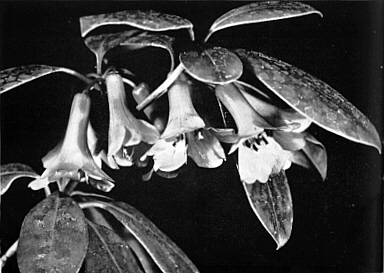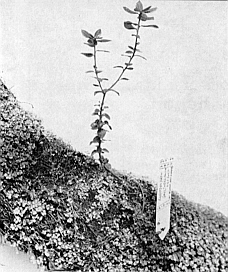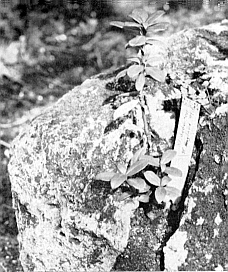The Malesian Rhododendrons at Kew
J. B. Simmons
Deputy Curator, Royal Botanic Gardens, Kew
In the latter part of the 19th Century plant collectors of the great nursery firm of James Veitch & Sons Ltd. of Chelsea introduced several species of rhododendrons from what was then the East Indies. A great many hybrids were raised and these became known as "Greenhouse" or "Java" rhododendrons and they were extremely popular in their day. For many years a large collection of these hybrids was grown at Kew but over the years this collection has gradually diminished. Of the species that were introduced at that time
Rhododendron jasminiflorum
,
R. multicolor
and
R. retusum
remain in cultivation at Kew to this day.
As a result of Dr. Sleumer's work on the
Ericaceae
of the Malesian region a renewal of interest occurred. In 1955
R. zoelleri
and
R. konori
were introduced to Kew followed two years later by
R. aequabile
from Sumatra. The collection has since been increased by material from New Guinea and Sabah and more recently the collection has been augmented by exchange of material with the Australian Rhododendron Society, Edinburgh Botanic Garden and Strybing Arboretum.
Because these plants came from tropical countries they were often, though wrongly, grown in warm greenhouses. At Kew they have to be maintained in a cool house all the year round for although we can grow them out of doors in slat houses during the summer they cannot withstand our winters. In general, we find them quite difficult to grow and there is little doubt that this is largely due to our winter conditions. The short winter days with their low light intensities bring growth to a standstill and any failure in watering at this stage brings certain death to the plant. By comparison with plants grown in Australia ours take much longer to produce their first flowers.
In recent years supplementary lighting (High Pressure Mercury Vapour Lamps) has been increasingly used at Kew, but not for these rhododendrons. Now, however, its use is to be extended to some of these plants and it is hoped that the additional lighting will solve some problems.
The water supply for these plants has also been a problem. The Thames valley is a chalk basin and so the water we receive is hard (pH 7.5). Most of the greenhouses at Kew have, therefore, rainwater storage tanks. In the Temperate House at Kew where these rhododendrons are grown, water from these underground tanks is pumped up into the house and fed to the plants via a mist watering system. In order to reduce the hardness of the water used in the propagating unit the cation section of a water softener was coupled in the spray lines, but did not prove successful, for reasons we have not discovered.
The first real success in establishing living plants after their long journey from New Guinea was achieved by plunging these plants directly into the mist propagation bed, and leaving them there until both new roots and new shoot growth had developed, instead of potting them up in the customary way.
Kew uses an intermittent mist system for propagation, the water for which is drawn from rainwater tanks and the bed heating is controlled by thermostats at 75° F. The air temperature is held around 60° F. and the propagating compost consists of (by volume) 4 parts sphagnum peat, 2 parts silver sand and one part 1/8" Durite (a calcined flint). Over the years confidence has been gained in this unit as greater success has been achieved with the establishment and propagation of the plants. A particularly satisfactory success was the rooting of hard and woody cuttings of material collected in Sarawak. At the same time some cuttings of
R. lochiae
from Bartle Frere in Queensland which were in a sorry state when received and seemed most unlikely to survive, were also rooted.

|
|
Fig. 51.
R. lochiae
, an Australian species with scarlet
2 inch bells, one of the most free flowering of the Malesian Rhododendrons at Kew. |
Plants grown at Kew propagate quite readily from cuttings which are taken when the base of the young shoots has lignified just sufficiently to feel firm to the touch. Material is taken at any time of the year when it is available.
Rooted cuttings of difficult species are potted up into a mixture of sphagnum moss and silver sand. Even those potted into standard mixes receive very careful weaning and watering until they are making satisfactory progress.
Raising the plants from seed has been difficult. The seed is short-lived, but even when it germinates the seedlings are hard to keep through their first winter. Seed has been sown in various composts, but the most useful is still that which contains a mixture of sand and peat. The plants must be moist but never wet. Placing the containers under intermittent mist was not effective-the seedlings damped off. They are now kept in their containers in a close case until large enough to stand out on a greenhouse bench.
Preliminary work on seed collected from Kew's plants of
R. zoelleri
shows that low temperature storage may extend viability up to nine months, and also that 14-21 days low temperature pre-sowing treatment stimulates germination. It is suspected that increasing the diurnal variation of temperature may stimulate germination in difficult cases of dormancy, and work will be extended to investigate this when time permits.
Many of the plants have to be kept in pots and this represents a risk because unskilled staff can easily over or underwater them, with dire results. The plants grow better in raised beds formed by using logs or wood or rock to support the sides, and they provide the good drainage which is so necessary. They have also been planted directly into tufa rock (a free draining limestone used by alpine plant growers), and grown as epiphytes on the trunks of tree ferns. In both cases the plants survived well but their growth was reduced. Various composts have been used for both the beds and the pots but so long as the mixture is acid, organic and very well drained the plants seem to tolerate the use of a wide range of materials. Because a light compost is used firm planting is essential.
Stock of each of the species is planted out in a collection house. Plants propagated from these are put on public display in the Himalayan House. The first plantings in this house were carried out in 1966. The earliest of these was
R. macgregoriae
and this has been the most prolific flowerer to date. Most of the plants seem to be flowering more freely and the old faithfuls
R. jasminiflorum and R. lochiae
have provided an excellent display this year. Kew has learnt much about the cultivation of these plants from Dr. Sleumer, Michael Black and other enthusiasts.

|

|
|
Fig.52.
R. gaultheriifolium
. A
seedling treated as an epiphyte; growing on the trunk of Dicksonia antartica. |
Fig.53. R. species, a seedling
growing on tufa rock; twelve months after planting. |
Kew's interest is naturally botanical and only the plant that is collected from a known source is of real value to the taxonomist, physiologist and cytologist. R. macgregoriae has been recently figured for the Botanical Magazine. Kew cytologists have examined the chromosome numbers of many of the Malesian rhododendrons that are in cultivation in the Gardens; most of them appear to be diploids. If a way can be found of crossing these plants with those from other sections of the genus then a whole new range of characteristics, including colour, form, scent and season of flowering can be given to our familiar garden rhododendrons. This is an exciting prospect, but even without this development the species themselves are of such beauty and interest that they are worthy of cultivation for their own sake.